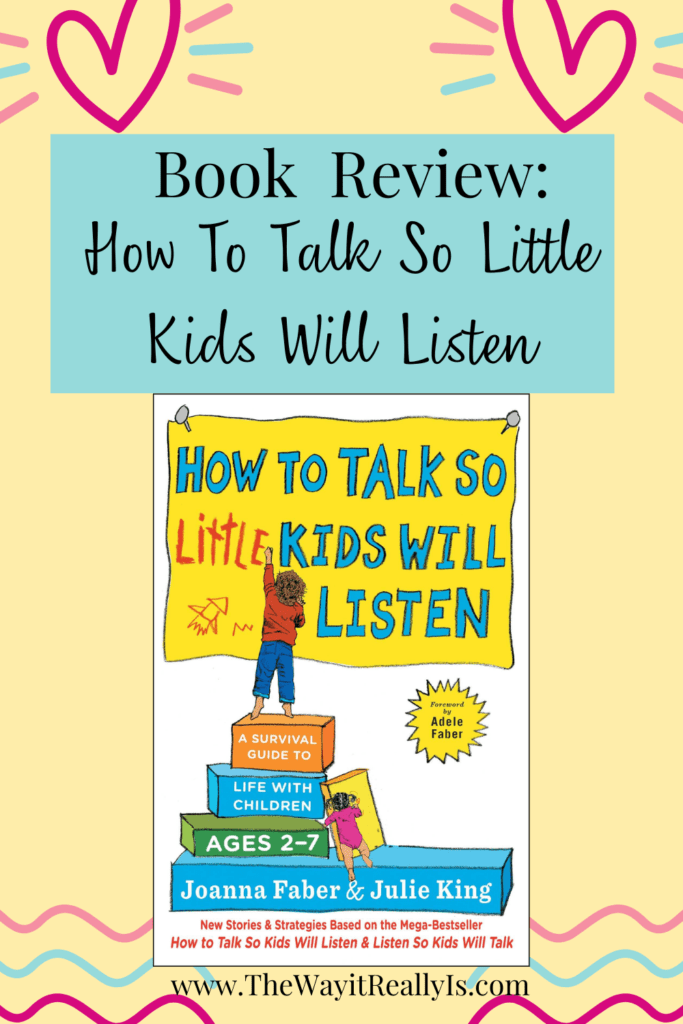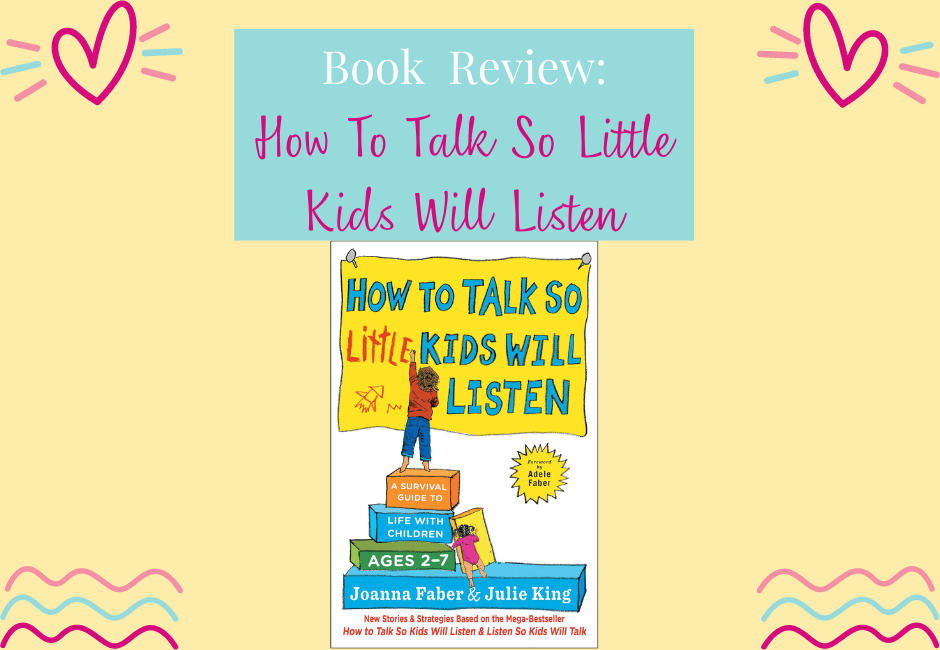If you’re struggling with getting your kids to listen to you, here is a book I highly recommend! There are so many tips within How to Talk so Little Kids Will Listen that will help you not only get your kids to listen but also strengthen your relationship with them.
Note: As an Amazon Affiliate I earn from qualifying purchases made through affiliate links, at no extra cost to you. Read my full disclosure for more information.
The Problem to Solve
At the time I started seeing my therapist, I was there for postpartum depression about 8 months after my twins were born. I had a singleton as well who was 2 at the time. I was very overwhelmed with everything, depressed, and on top of it all, my 2-year-old would NOT listen to me!
General not listening is one thing but it became a safety issue quite often. At times it was as simple as him being loud when his brothers were napping but would escalate to him jumping off the couch, going down the stairs head first, etc. All very unsafe things that obviously could not be allowed but he wouldn’t listen when I said to stop. Or even when I yelled STOP!!!
The Book…And My Procrastination
I was talking to my therapist about this one day and she happened to have the How to Talk so Little Kids Will Listen: A Survival Guide to Life with Children Ages 2-7 on her desk. She picked up the book and said she had just started reading it and was finding it to have a lot of great information.
Like any overwhelmed mom, I was skeptical that this book to have answers to help me, but also was willing to give anything a try. I went home and I bought the book.
…The book sat on my pile of books to read for nearly a year. It’s as though I thought, like I do with a lot of books, that by simply having the book, I would magically be helped. Obviously, that wasn’t the case.
By the time the twins were 2 and my oldest was 4, I had to crack this book open. I was in desperate need as now I had 3 defiant children who wouldn’t listen to me and none of my school psychologist tricks were working!!!
I decided to listen to it on audiobook through my library and also have the book nearby to reference or highlight as needed. This seemed to be the perfect solution.
How to Talk so Little Kids Will Listen Book Outline
The book is broken into two parts: The Essential Toolbox and The Tools in Action.
The Essential Toolbox is full of different tools to help you better understand yourself and your own emotions, as well as help get your kids to listen by talking to them in different ways. There are also many stories from parents that show the need for help, as I’m sure we all have, and later what ultimately did help and what it looked like when they used the tools in their new toolbox.
The chapters are as follows:
Part 1: The Essential Toolbox
Chapters
- Tools for Handling Emotions – What’s all the fuss about feelings?
This chapter also includes explanation regarding when kids don’t feel right, they can’t behave right. - Tools for Engaging Cooperation…Feelings Schmeelings, She Has to Brush Her Teeth
This chapter is about how to get kids to do what they have to do. - Tools for Resovling Conflict…Avoiding Combat on the Home Front
This chapter is about replacing punishment with more peaceful, effective solutions. - Tools for Praise and Appreciation…Not All Odes Are Equal – Ways to praise that will help, not hinder
This chapter is about how to use praise and appreication in more specific and helpful ways than just a basic ‘good job’ thrown in here and there. - Tools for Kids Who Are Differently Wired…Will This Work with My Kid?
This chapter has several modifications for kids on the spectrum, with sensory considerations, hyperactive behavior, and beyond. It’s great to have this chapter because I was surely one of those parents who felt at first that this stuff wouldn’t work with at least one of my kids because he’s a bit atypical. This chapter gave me a lot of ways to adapt the earlier toolbox chapters to fit my child.- Chapter 5-1/4: The Basics…You Can’t Talk Your Way Out of These – Conditions under which the tools won’t work This chapter goes into the fact that sometimes there are situations in which these tactics may not work.
Part II: The Tools in Action
Chapters
- Food Fights – The Battle at the Kitchen Table
- Morning Madness – Escaping the Intense Gravational Pull of Your Home
- Sibling Rivalry – Give the Baby Back!
- Shopping with Children – Mayhem at the Market
- Lies -Kids and the Creative Interpretation of Reality
- Parents Have Feelings, Too
- Tattling-Snitches and Whistle-Blowers
- Cleanup-The Dirtiest Word
- Doctor’s Orders-Medicine, Shots, Blood Draws, and Other Horrors
- Shy Kids-Fear of Friendly Folks
- Little Runaways-Kids Who Take Off in the Parking Lot and Other Public Places
- Hitting, Pinching, Poking, Punching, Pushing – I Barely Touched Him!
- Sleep-The Holy Grail
- When Parents Get Angry
- Troubleshooting – When the Tools Don’t Work
The End? (that’s the last chapter, with some final words)
An Easy to Read & Well Organized Book
Throughout the book, I really enjoyed the toolbox call-outs and graphics as well as the use of secondary headers within the text, and very important point call-outs. These things really help break the book up, make it more easily read for busy parents, and often even some comic relief.
The stories from actual parents from the parenting group the authors are talking about are so critical to this book. I really heard myself and saw my kids within these stories, they are so real and relatable. To that point, I also saw my kids and myself in the sections about when the parents actually tried the toolbox suggestions with their children.
The end of each chapter features a toolbox review and very important points they highlighted throughout the chapter. I actually typed up the review sections at the end of the chapter and printed them out so I can have them on hand.
I’ve even found putting a section of them up on the fridge helps because I’ll mindlessly read it while I’m refilling my water or getting something out of the fridge. Then every few days I switch to another page of the review I printed out.
Just a suggestion for a refresher after reading.
…But Does it Actually Help?!
Yes. It does as long as you try. Simply owning the book or just listening to the book without putting words into action, won’t do a darn thing, I quickly learned. Once I typed up the review at the end of each chapter and hung them on the fridge, suddenly I was getting somewhere. I’d try a different tactic every few days or so. The first one I tried out was in chapter 1 and it is not using “but” and replacing it with “the problem is”. It seems so simple yet worked.
Another tactic I put into place rather easily was acknowledging feelings with words, which the authors go over in the first chapter as well. When one of my children is angry I’ll often say something like, “You wanted to play with the toy your brother had but he won’t let you. That makes you angry.” This works especially well on my now 3-year-old twins who suddenly will look like a light bulb went off in their head like ‘yes, yes I am angry’.
I have to admit, I have gotten lax on trying more items from the toolboxes the writers provide. I need to put the cheat sheet back on the fridge so I get back into trying new things and brushing up on the old. They really do work though if you use them.

As a mom of identical twins and a son two years older, I have gained invaluable experience in the realm, and chaos, of parenting. With a Master's Degree and Education Specialist Degree in School Psychology, I spent years as a school psychologist, helping children navigate through their educational and emotional challenges. Now as a stay at home mom and professional blogger, I combine my areas of expertise to help you in your parenting journey.



Thank you for reviewing our book! I love that you rotate reminders on your fridge!
You’re welcome! Thank you and Joanna Faber for writing this book, it’s really helped us so much. I feel honored that you found and read my review! 🙂